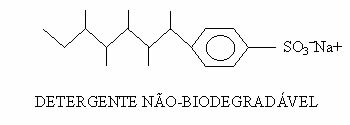Those who care about the environment will be interested in this issue: which detergents are biodegradable or not?
In general, detergents in Brazil are made from a mixture of sodium alkyl benzene sulphonates and are classified as biodegradable or non-biodegradable detergent. The difference between them starts in the carbon chain that constitutes them.
Note that the hydrocarbon chain to the left of the molecule has no branches, it is classified as linear.
A detergent is considered non-biodegradable if its molecule contains ramifications, see below:
The detergents you use at home end up in rivers through the sewer system and are responsible for the pollution known as "detergent swans". The name is suggestive, as they are whitish and dense foams that prevent the entry of oxygen gas into the water, which affects aquatic aerobic forms.
But why do carbon chain ramifications make detergent non-biodegradable?
Microorganisms in water produce enzymes capable of breaking down the linear chain molecules present in biodegradable detergents. But these same enzymes do not recognize the branched chains present in non-biodegradable detergents, which is why they remain in the water without undergoing decomposition. The accumulation causes the formation of detergent swans.
If you observe the biodegradable seal on detergents, consider taking this home, you will be avoiding the contamination of rivers and seas.
By Líria Alves
Graduated in Chemistry
Source: Brazil School - https://brasilescola.uol.com.br/quimica/por-que-detergentes-poluem.htm
